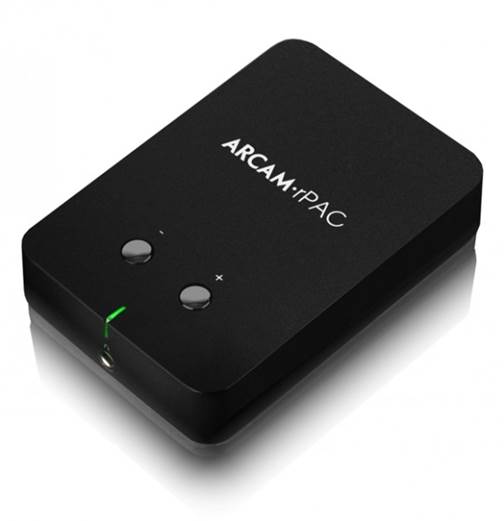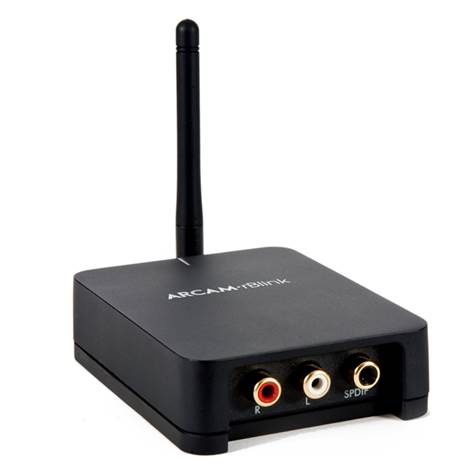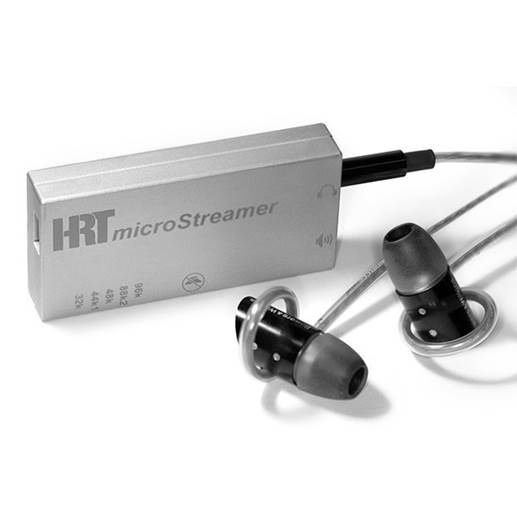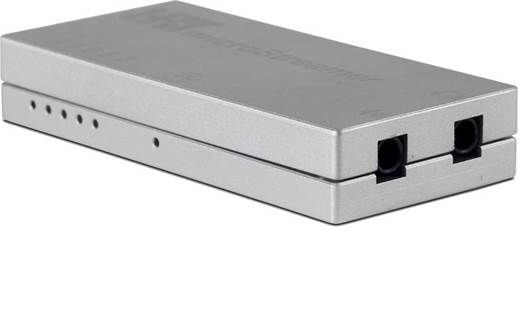ARCAM rPAC: $254
If we were missing the headphone output on
the Arcam rDAC, Arcam’s got a pocket-sized alternative up its sleeve. The Arcam
rPAC doubles up as both a DAC and a headphone amplifier, all housed in a
compact box that eschews the need for mains power.
The rPAC weighs just 300g, making it light
and portable enough to carry around in your bag if you’re using your laptop on
the move. Connections are minimal but practical: a type-B USB input a pair of
line-level RCA outputs and a headphone output.

ARCAM
rPAC
You can use the line-level outputs to
connect to your existing hi-fi set up, but we imagine the rPAC’s most popular
use will be between a laptop/computer and a pair of headphones.
Rather conveniently, the rPAC comes with
its own mini-USB to USB cable, but we found the wire length to be a bit too
long, leading to tangled complications. In comparison, the supplied USB wires
of other portable DACs in this test – such as the HRT micro-Streamer and the
Meridian Explorer are much shorter and more practical.
The only distinctive marking on the rPAC’s
compact case is the volume control buttons: tap or hold to change the volume
when using it with headphones. Reminiscent of the rDAC design, a single light
indicator flashes red-to-green when the rPAC is in use, and blinks when
changing the volume.
The rPAC weighs just 300g, making it
light and portable enough to carry around in your bag if you’re using your
laptop on the move

If
you like a smooth sound and appreciate the rPAC’s portability, $254 isn’t much
Just plug ‘n’ play
Plug in a pair of headphones to the rPAC’s
3.5mm socket, and you’re good to go. The rPAC’s USB input handles file types up
to 24 bit/96 kHz, which is ample opportunity to boost the sonic performance of
your laptop when playing all types of music files.
Play a WAV recording of The Noisette’s
Don’t Give Up, and the sound is clear and detailed, with a smooth overall
balance. There’s much of the dynamism and agile timing that we appreciated in
Arcam’s rDAC, along with a great sense of naturalness to voices. Instruments
are rendered with weight and rich textures, and overall it’s an enjoyable
sound.
There’s no sense of hardness or brightness
to be found at all, which is great when you don’t want to wear your ears out
with insistent, hard electronic beats. However, some might find the
presentation just a touch too smooth, and it’s true that other DACs, such as
the Audio quest DragonFly or the HRT micro-Streamer do offer a more attacking
vibe. To round off the comparison, the HRT goes that extra mile in revealing a
greater deal of subtlety and depth, with punchier bass-lines.

Plug
in a pair of headphones to the rPAC’s 3.5mm socket, and you’re good to go. The
rPAC’s USB input handles file types up to 24 bit/96 kHz
In essence, the rPAC has the same sonic
characteristics as the rDAC – but it’s a semi-skimmed performance compared with
the rDAC’s full-fat, authoritative and detailed delivery.
The rPAC’s portability and great price tag
of $254.5 still makes it a desirable hi-fi option, but there are some newDACs
on the block now. The emergence of even more compact and capable alternatives
(the HRT, Meridian Explorer and DragonFly) means the rPAC has had a star
docked. But don’t be deterred: it’s an enjoyable DAC that’s worth your money.
Rating: 4/5
For: Portable build; smooth performance;
natural, enjoyable sound; good balance
Against: Faces some stiff competition from
new – sometimes more compact – rivals
Verdict: More desirable alternatives exist,
but the rPAC still has plenty of merit
Arcam rPAC specs
·
USB in: 1
·
Coaxial digital in: 0
·
Optical digital in: 0
·
RCA in: 0
·
RCA out: 1
·
XLR out: 0
·
Optical digital out: 0
·
Coaxial digital out: 0
·
Headphone: 1
·
Wireless: No
·
Finishes: 1
·
Dimensions (H x W x D): 3 x 10 x 6cm
·
Performance: 4
·
Feature: 4
·
Build: 5
HRT micro-Streamer: $360
A DAC-and-headphone-amplifier tucked into a
tiny, portable shell that’ll do wonders to the sound quality of your
computer-stored music? That’s the HRT micro-Streamer down to a tee.
High Resolution Technologies is no stranger
to producing great-sounding USB DACs – the Music Streamer II was a 2011 Award
winner and they’ve gone and pushed the envelope even further with the
micro-Streamer.

HRT
micro-Streamer
Comparisons with the Audio quest DragonFly
were rife in our offices, along with references to the newly launched Meridian
Explorer. The micro-Streamer is a light aluminum enclosure with an asynchronous
USB design. This means that it, rather than the circuitry in your computer,
controls the data flow, leading to more accurate timing and better all-round
performance.
Clear information
There are neat little icons on the fascia
to identify the line-level and headphone outputs, as well as indicate mute
status. The micro-Streamer is capable of playing files up to 24-bit/96kHz
resolution, and LED indicators on the side light up amber to show which kHz
sample rate – 32, 44.1, 44, 88.2, and 96 – is playing. It’s nice to see such an
informative system packed onto such a small surface area. Some might prefer the
built-in USB connector design of the DragonFly, but the micro-Streamer is dinky
enough to fit into the palm of your hand, and we like the flexibility of
connecting it to your computer’s USB port with a very short (supplied) cable.
That way, there’s no danger of knocking it out or damaging it when moving your
laptop, as you might with the DragonFly’s design.

Judge
me by my size, do you? Unwise – this tiny DAC has abilities to belie its
dimensions
Let’s come straight out with it – no other
USB DAC of this design betters the brilliantly musical and dynamic performance
of the micro-Streamer. Stream Rage against the Machine’s killing in the Name,
and the sound is solid and muscular, with no hint of hardness. The ability to
start and stop notes with precision is combined with a superbly agile sense of
rhythm that allows the micro-Streamer to zing through the track with
confidence.
Enthusiasm and energy walk hand in hand
with refinement and elegance here. A live recording of Yann Tiersen’s violin
solo Sur Le Fil is revealing: the sense of space around the performance is
amply conveyed, and the bow scraping across the strings feels raw and tangible.
Let’s come straight out with it – no
other DAC of this design betters the musical and dynamic performance given by
the micro-Streamer
Attention to detail
It’s the micro-Streamer’s ability to dig up
layer upon layer of detail in a recording that delivers such an immersive
experience. Voices are full of subtlety and rich textures that connect
emotionally with the listener.
The Meridian Explorer shares a similar
level of detail retrieval and balance, but the micro-Streamer is just a touch
more transparent, melodic and insightful.
Last but not least, this little block will
cost you just $360.99. Its incredible value for money: from its size and ease
of use to its wonderfully engaging sound, this little DAC will have you
replaying your entire digital music collection just to hear how good it can

This
little DAC will have you replaying your entire digital music collection just to
hear how good it can
Rating: 5/5
For: Enthusiastic and engaging performance;
fast and agile timing; subtle and insightful detail; tiny, light and portable
build
Against: Nothing at this price
Verdict: The best portable DAC/headphone
amplifier you can buy now? A resounding ‘yes’
HRT microStreamer specs
·
USB in: 1
·
Coaxial digital in: 0
·
Optical digital in: 0
·
RCA in: 0
·
RCA out: 0
·
XLR out: 0
·
Optical digital out: 0
·
Coaxial digital out: 0
·
Headphone: 1
·
Wireless: No
·
Finishes: 1
·
Dimensions (H x W x D): 1 x 3 x 6cm
·
Performance: 5
·
Feature: 4
·
Build: 5